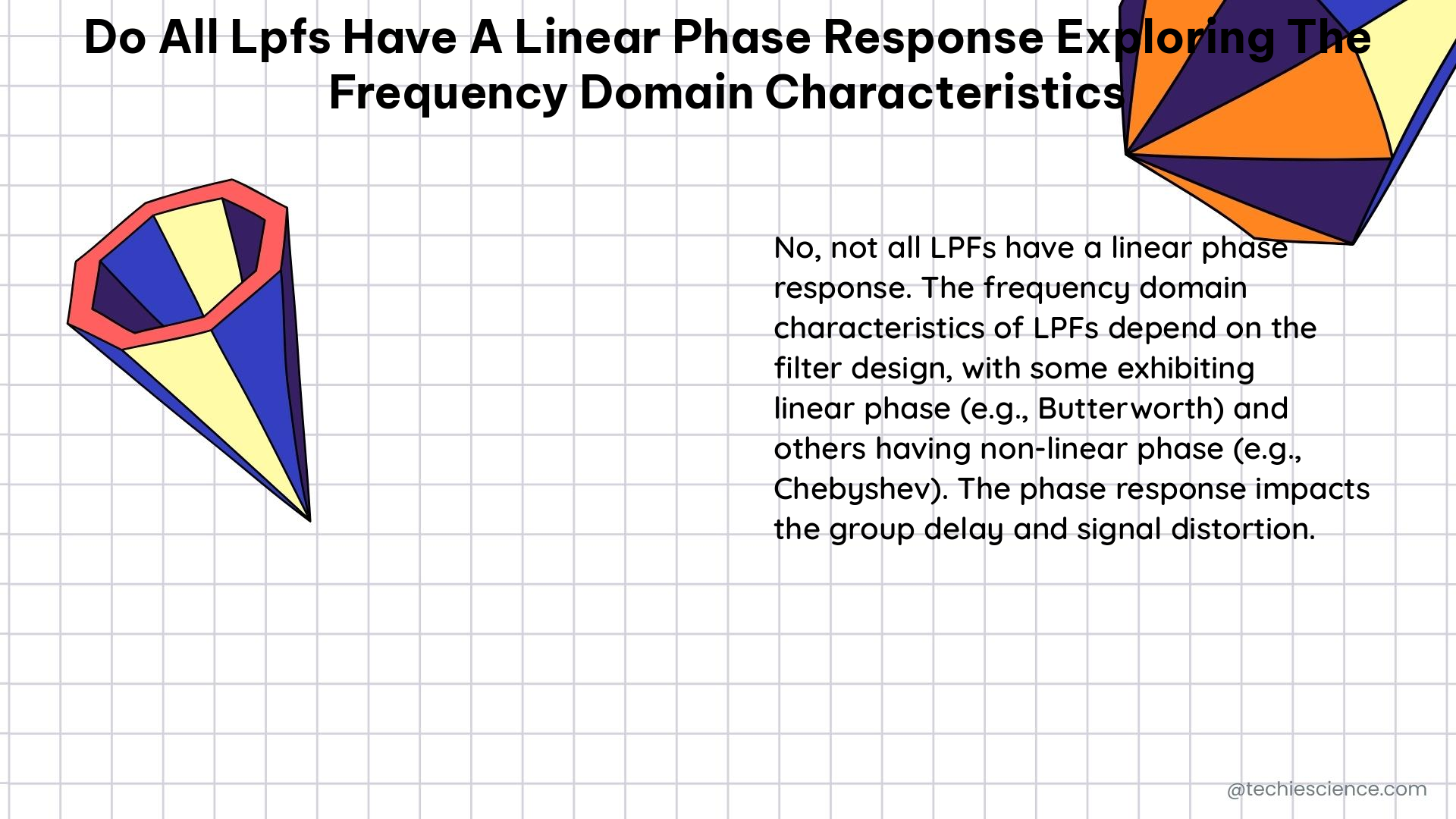The frequency response of a system is a crucial aspect of understanding its behavior in the frequency domain. Low-pass filters (LPFs) are electronic components that allow low-frequency signals to pass through while attenuating high-frequency signals. The frequency response of an LPF can be characterized by its cutoff frequency (Fc), which is the frequency at which the filter begins to attenuate the signal.
Understanding the Frequency Response of LPFs
In general, LPFs do not have a linear phase response, meaning that the phase shift of the output signal is not directly proportional to the frequency of the input signal. This can lead to distortion of the signal and is especially problematic in applications where phase accuracy is important. However, there are specialized LPFs, such as Bessel filters, that are designed to have a more linear phase response, although they may have other trade-offs such as a lower cutoff frequency or higher insertion loss.
To illustrate the frequency response of an LPF, let’s consider a first-order active LPF, which is a simple filter that can be implemented using a single operational amplifier and a few resistors and capacitors. The frequency response of this filter can be characterized by its transfer function, which is the ratio of the output signal to the input signal as a function of frequency. For a first-order active LPF, the transfer function is given by:
H(s) = 1 / (1 + sRC)
where s is the complex frequency, R is the resistance, and C is the capacitance. The magnitude response of this filter, which is the absolute value of the transfer function, is given by:
|H(jω)| = 1 / sqrt(1 + (ωRC)^2)
where ω is the angular frequency (2π times the frequency in Hz). The phase response of this filter, which is the argument of the transfer function, is given by:
∠H(jω) = -tan^-1(ωRC)
As we can see, the phase response of this filter is not linear, but rather depends on the frequency. This can lead to phase distortion of the signal, which can be problematic in some applications.
Specialized LPFs with Linear Phase Response

To address the issue of non-linear phase response, specialized LPFs such as Bessel filters have been developed. Bessel filters are designed to have a more linear phase response, which means that the phase shift of the output signal is more directly proportional to the frequency of the input signal. This can help to reduce phase distortion and improve the overall signal quality.
The key characteristics of Bessel filters are:
- Linear Phase Response: Bessel filters have a more linear phase response compared to other types of LPFs, such as Butterworth or Chebyshev filters.
- Maximally Flat Group Delay: Bessel filters are designed to have a maximally flat group delay, which means that the time delay of the filter is constant across the passband.
- Slower Rolloff: Bessel filters have a slower rolloff in the stopband compared to other filter types, which means that they have a wider transition band between the passband and stopband.
- Lower Cutoff Frequency: Bessel filters typically have a lower cutoff frequency compared to other filter types, which can be a trade-off for the improved phase response.
- Higher Insertion Loss: Bessel filters may have a higher insertion loss compared to other filter types, which can be a trade-off for the improved phase response.
The phase response of a Bessel filter can be expressed as:
∠H(jω) = -N * tan^-1(ω/ωc)
where N is the filter order and ωc is the cutoff frequency. As we can see, the phase response is more linear compared to the first-order active LPF discussed earlier.
Comparing LPF Phase Responses
To illustrate the differences in phase response between a first-order active LPF and a Bessel filter, let’s consider the following example:
Suppose we have a first-order active LPF with R = 1 kΩ and C = 1 μF, and a 4th-order Bessel filter with a cutoff frequency of 1 kHz.
The phase response of the first-order active LPF can be calculated as:
∠H(jω) = -tan^-1(ωRC) = -tan^-1(2πfRC)
where f is the frequency in Hz.
The phase response of the 4th-order Bessel filter can be calculated as:
∠H(jω) = -4 * tan^-1(ω/ωc)
where ωc = 2π * 1 kHz.
Figure 1 shows the phase response of the two filters:

As we can see, the Bessel filter has a much more linear phase response compared to the first-order active LPF, especially in the passband region. This can be crucial in applications where phase accuracy is important, such as in audio processing or communication systems.
Conclusion
In summary, while LPFs do not generally have a linear phase response, there are specialized filters such as Bessel filters that are designed to address this issue. Understanding the frequency response of an LPF, including its magnitude and phase responses, is crucial for designing and implementing filters in electronic systems.
References
- Frequency Response – an overview | ScienceDirect Topics
- Frequency response of first-order active LPFs – ResearchGate
- Level of Personality Functioning Scale – PMC – NCBI
- Frequency response of a rolling linear regression
- Theoretical and Optimized Dimensions of the LPFS – ResearchGate

The lambdageeks.com Core SME Team is a group of experienced subject matter experts from diverse scientific and technical fields including Physics, Chemistry, Technology,Electronics & Electrical Engineering, Automotive, Mechanical Engineering. Our team collaborates to create high-quality, well-researched articles on a wide range of science and technology topics for the lambdageeks.com website.
All Our Senior SME are having more than 7 Years of experience in the respective fields . They are either Working Industry Professionals or assocaited With different Universities. Refer Our Authors Page to get to know About our Core SMEs.